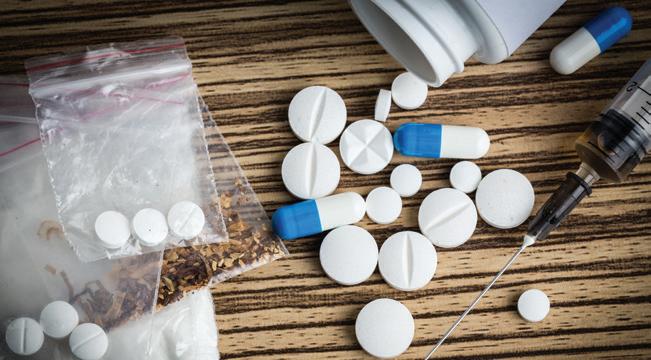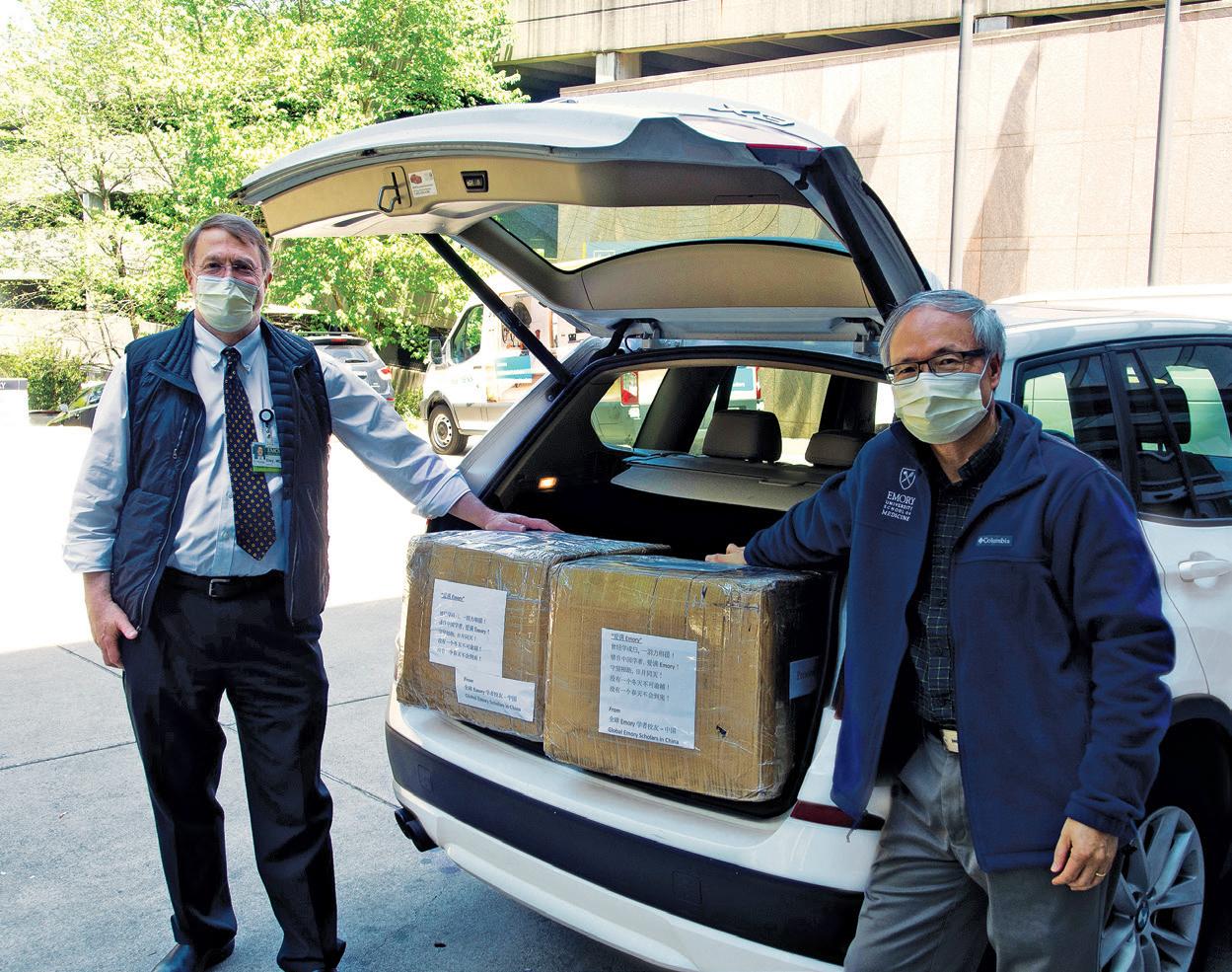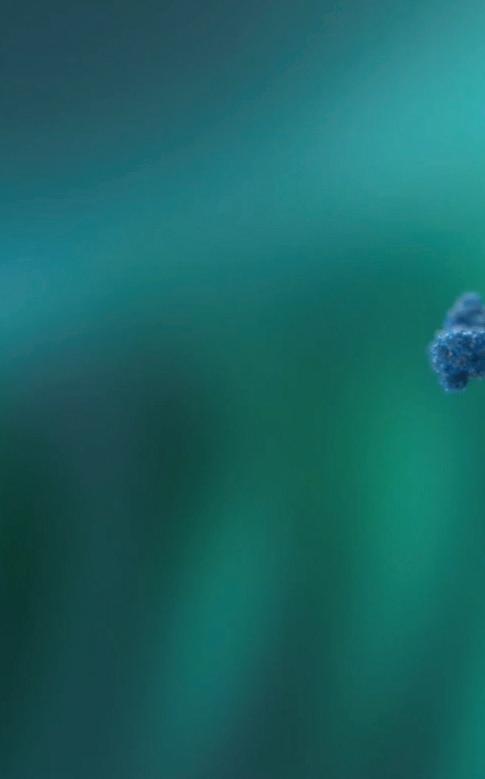
14 minute read
Briefs
Flu Shots: Never More Important
Get your flu shot—now, if you haven’t already.
That’s the advice from experts this year, who fear a “twindemic” of COVID-19 and influenza during the normal flu season.
“It takes two to three weeks for the vaccine to build immunity in the body, and getting vaccinated early can help prevent transmission,” says Walt Orenstein, associate director of the Emory Vaccine Center and professor of infectious diseases at Emory’s School of Medicine.
And the flu virus, like the novel coronavirus, can be wily.
“Once exposed to influenza, an individual tends to get sick in a range of one to four days,” Orenstein says. “People are most contagious in the first three to four days of illness. But some people can transmit the virus before they even get sick and can also transmit from five to seven days after becoming sick.”
The flu virus can mutate, Orenstein says. There are about four major strains of influenza viruses in most vaccines. In the overall population, the CDC says studies show a vaccine can reduce the risk of flu by about 50% to 60% when the vaccine is well matched.
Experts estimate the vaccine for the 2019–20 influenza season was about 38% effective. “We’d like a more effective vaccine,” Orenstein says, “but the [current vaccines] are still a lot better than zero percent, which is the effectiveness of no vaccination.” Pregnant women are encouraged to get a flu shot to protect their newborns, since only babies 6 months of age and older can be vaccinated; the mother’s vaccination provides passive immunity to the newborn. With the threat of COVID-19 as well as other illnesses that could lead to pneumonia, it’s even more important to get a flu shot this year. Having influenza and COVID-19 at the same time could be catastrophic for an individual, and having simultaneous or overlapping epidemics of influenza and COVID-19 would put tremendous stress on the health care delivery system.—Dr. Walter Orenstein, speaking to WABE-FM, Sept. 16, 2020.
CDC estimates* that, from October 1, 2019, through April 4, 2020, there have been:
39 million to 56 million flu illnesses
18 million to 26 million flu medical visits
410,000 to 740,000 flu hospitalizations
24,000 to 62,000 flu deaths
*These estimates are calculated based on CDC’s weekly influenza surveillance data.
A New Hope: The Addiction Alliance of Georgia
With needs growing amid the pandemic, Emory Healthcare and the Hazelden Betty Ford Foundation are partnering with collaborators throughout Georgia in a long-term venture to reduce addiction, improve recovery, and save lives.
More than 20 million Americans needed substance-use treatment in 2019, but only about one in 10 received the specialty care they needed. Addiction to alcohol, opioids, and other drugs is a leading cause of disease, disability, and premature death, with drug overdoses alone taking a record 72,000 lives in the US in 2019. The Addiction Alliance of Georgia will focus initially on outreach, education, and reducing stigma by providing a better understanding of addiction as a chronic, treatable disease. In 2021, it plans to offer clinical services in Atlanta.
Currently, “in response to the pandemic and the dramatically increased demand, Emory and Hazelden Betty Ford have both used telehealth effectively and extensively to help people with substance-use disorders,” said Mark Hyman Rapaport, chair of Psychiatry and Behavioral Sciences at Emory School of Medicine and chief of Psychiatric Services at Emory Healthcare.
Information on existing services can be found at AddictionAllianceOfGeorgia.org.—Jennifer Johnson

Animal Care during COVID
As part of its research mission, Emory cares for thousands of
animals across the enterprise—at Yerkes National Primate Research Center alone there are about 5,000 mice, rats, and voles, and 3,400 nonhuman primates split between Yerkes’ 25-acre main campus and its 117-acre field station in Lawrenceville, Georgia.
These animals require many human caregivers, from vets and vet technicians to behavioral management specialists, resource managers, and animal care technicians, as well as the researchers and research assistants whose work translates into new therapies, vaccines, and discoveries that aid health and well-being— including research on COVID-19. “Our biggest challenge has been working through reduced staffing, which we had to facilitate initially because we split our groups into teams so we would not expose all of our personnel at the same time,” says veterinarian Joyce Cohen, associate director of the Yerkes Division of Animal Resources. “Now it’s because of virtual learning considerations for our employees’ children.” Everyone stepped up to the plate, working doubly hard, says Cohen, associate professor in the division of psychiatry and behavioral science at Emory’s School of Medicine. “And they are all wearing Personal Protective Equipment (PPE) every time they work with the nonhuman primates, to protect the animals from diseases we carry as well as to protect staff from natural diseases the monkeys carry. Even before COVID, this was the case.”
During the height of the pandemic, Yerkes tamped down some of its research, and the only new studies accepted were COVID-19 research. But staff tried to preserve as many ongoing studies as possible. “Our Biosafety Level 3 lab is up and running, which takes a tremendous amount of time and energy,” Cohen says. “We always feel there is a need for animal research, and an emerging infectious disease is a great example of why we still need to have it. Nonhuman primates are very good models for emerging infectious diseases like COVID. It is absolutely critical to have these animals ready so we can jump right on vaccines and treatments.”
The field station’s monkey colonies also require constant, careful tending. For example, the rhesus macaques—Yerkes’ primary species—came into baby season during the pandemic, which meant a lot of work for caregivers. Animals are housed in pairs when possible to make sure they have a social partner. At the field station, where the behavioral research social colonies are housed, workers monitor social interactions of large groups, from five to 150.
Chimpanzees can no longer be used in research so Yerkes’ chimps were “retired,” but Emory still provides them the same level of care while it pursues donation opportunities. “Chimps are notorious for being susceptible to human respiratory infections, and many of them are geriatric at this point,” Cohen says. “We are doing



PHOTO CREDIT: DENISE BONENBERGER
our best to protect them.” Emory School of Medicine researchers have ongoing studies involving a plethora of animals kept in vivariums and research buildings across campus, including 75,000 mice plus rats, pigs, sheep, rabbits, guinea pigs, hamsters, gerbils, songbirds, voles, spiny mice, zebra fish, and lampreys. “Our challenges are centered around caring for animals in nine housing locations,” says Michael Huerkamp, director of the Division of Animal Resources and professor of pathology and laboratory medicine at Emory School of Medicine.
Certain species have unique attributes that make them valuable for specific lines of scientific inquiry, Huerkamp says.
“We’re fortunate to have dedicated pros on our teams, with longevity and specialized skills,” he says. “This work is vital to the mission of the university. We also want to get everyone to the other side of COVID, staying healthy along the way.”—Mary Loftus
Stocking up on PPE
J. William Eley, executive associate dean for education (left), and Haian Fu, chair, pharmacology and chemical biology, stand beside 6,200 masks donated by the Global Emory Scholars in China.
Ahuge challenge during the pandemic for hospitals around the world has been keeping a constant supply of personal protective equipment (PPE), such as medical-grade masks, gloves, and gowns, in stock for health care workers. As demand intensified, Emory Healthcare used multiple supply chains from around the world, as well as local distributors and manufacturers, to stabilize its supply. It also opened a drive-through community donation center on the Emory campus for PPE in March.
“We have been ordering from other countries— Mexico, Central America, Vietnam, and other Southeast Asian countries as well,” says Lee Partridge, director of Supply Management at Emory Healthcare.
Emory secured a robust stock of PPE in the form of masks, gloves, and sanitary wipes, numbering in the hundreds of thousands. A significant portion of these donations came from China.
For example, Global Emory Scholars in China, a group of former School of Medicine trainees who returned home after their training, donated more than 6,000 masks purchased through a fundraising effort called Love Emory (see photo, above).
Although constant restocking is required, PPE supply chains have normalized a bit after the initial surges.
“We have focused on sourcing from American manufacturers as much as possible,” Partridge says.

PHOTO COURTESY OF BILL ELEY
Sent with the Global Emory Scholars donation was a poem:
Returned to homeland as better scholars / our love and support for Emory again brings us together. / Although thousands of miles apart, / a shared universe connects our hearts. / The darkness of winter never stays forever, / the hope and joy of spring is just around the corner. / Hand in hand we stay strong, / fighting for a COVID-free world where we all belong.
By purchasing from these manufacturers in bulk and opening a warehouse for future needs, Emory Healthcare is now stable with most required protective garb.
Partridge says Emory Healthcare will continue seeking reliable sources that can provide the requested supplies. These protective products are more valuable than ever as the coronavirus makes a resurgence in different areas around the country.
Preserving multiple supply chains is key to ensuring that medical professionals remain safe when treating patients with COVID-19, he says.
Medical teams have also been charged with making their PPE last longer, by disinfecting and reusing their personal supplies. The Centers for Disease Control and Prevention (CDC) provides guidelines so that doctors and nurses can extend their use of protective gear such as N95 respirator masks and face shields.
According to Kari Love, program director of infection prevention at Emory Healthcare, one of the ways this equipment is being conserved is through an Emergency Use Authorization for reprocessing N95 respirators.
Under normal conditions, hospital staff would dispose of the masks after initial use, but those practices needed adjustment as the virus continued to spread.
The CDC also recommends eye protection when treating patients with COVID-19, so rather than throw away these face shields, Emory Healthcare workers disinfect their shields.
“Our supply chain team has also sourced a variety of different types of eye protection, including face shields and goggles,” Love says. “Georgia Tech also worked with us to create a face shield that has a headband that is sturdy enough to be reused.”—Kofi Stiles

Your Doctor Is Calling
Matthew Pombo is demonstrating how to conduct a
telehealth visit for knee pain. “You should first make sure the patient is wearing shorts and is at least six feet from their camera. If you suspect a meniscal tear,” he says, “have the patient do a squat on one leg and twist. If they say their knee hurts on one side, you consider the meniscus.”
Specialists from across Emory, from ortho to ENT to GI, are using their lunch hour to demonstrate to medical colleagues and trainees how best to conduct a telehealth visit, because that is the way they are seeing many of their patients these days.
Emory Healthcare has seen exponential growth in telehealth visits during the COVID-19 pandemic, with more than 215,000 from mid-March to July. Prior to COVID, Emory Healthcare conducted several telehealth visits per week in only a few specialties. Since mid-March, Emory has been conducting an average of 12,000 telehealth visits per week across 38 specialties.
Emory Connected Care enables patients to consult with health care providers from their home using technologies such as a webcam or a mobile device with a camera.“The speed and quality in establishing a robust telehealth practice from very few visits a week to around 12,000 per week has been an amazing transformation,” says Gregory Esper, professor of neurology, associate chief medical officer at
Emory Healthcare, and lead for telehealth initiatives. During the COVID-19 peak in April, when in-person doctor’s appointments were limited, Emory Healthcare conducted 57% of its visits via telehealth.“These remarkable achievements, supported by tremendous behind-thescenes efforts, have allowed our patients to continue seamless care with their health care providers during the COVID-19 crisis,” says Jonathan Lewin, CEO, Emory Healthcare. “While many of our specialty areas are now gradually and safely resuming in-person appointments, telehealth has been an essential offering to patients, and many continue to use this service.”—Janet
Christenbury

ADVERTISEMENT ILLUSTRATION DARIA KIRPACH
Helping Heroes Aff ord Life
Special Pricing on select loans

Visit emoryacu.com for details and additional bonuses.
Showing our appreciation and support for Healthcare workers and First Responders
INSURED BY NCUA • DEKALB AND FULTON COUNTY RESIDENTS ARE ELIGIBLE TO JOIN
When a Heart Stops: Improving Cardiac Arrest Survival Rates through CARES
The mother of five, in her mid-50s, was talking away one minute and had collapsed onto the carpet in her bed-
room the next. Her husband noticed the sudden quiet and found her on the floor not breathing. He called 911 and started cardiopulmonary resuscitation (CPR) under the direction of the dispatcher. An ambulance came minutes later and first responders used a defibrillator to shock her heart to a perfusing rhythm before transporting her—awake and alert—to the hospital, where she had coronary artery bypass surgery.
She was one of the lucky ones. Most victims of sudden cardiac arrest who are not already in the hospital are not so fortunate.
Sudden cardiac arrest results from an abrupt loss of heart function and is the leading cause of death among adults in the US. Each year, nearly 350,000 people experience a cardiac arrest outside of the hospital, most in their own homes, and about 90% of them die.
“Cardiac arrest develops due to electrical instability in the heart and might be precipitated by a heart attack, a congenital heart defect, or occur during exercise or from an unknown cause. Patients often have no warning or preceding symptoms. The person is walking and talking one minute and the next is collapsed, clinically dead,” says Bryan McNally, executive director for CARES and Emory professor of emergency medicine.
The chain of events that begins that very moment can determine if the person lives or dies. “For every minute that person’s heart has stopped, survival drops 7 to 10 percent,” says McNally. “But if a bystander performs chest compressions (hands-only CPR), that can double or triple survival.”
Communities that measure outcomes and perform basic improvement activities, like dispatcher CPR education, can improve survival. Enter CARES (the Cardiac Arrest Registry to Enhance Survival), which collects data on cardiac arrest survival rates and other performance metrics. “Prior to CARES, most communities had no understanding of what happens to a patient whose heart stops, making it impossible to understand how the EMS system is performing or how to improve,” McNally says.
Developed by the Centers for Disease Control and Prevention (CDC) and Emory’s Department of Emergency Medicine in 2004, the registry links crucial information from three sources—911 dispatch centers, EMS providers, and receiving hospitals—to create a single record for each person who experiences a sudden cardiac arrest outside of hospitals. “CARES helps communities identify how to improve cardiac arrest survival rates by acting locally,” says McNally. “The program uses data to drive performance and improve care.” Since its inception at Emory and use in Atlanta, the registry has grown to include 28 statewide registries and 50 additional communities in 13 states. CARES has recorded the details of more than 500,000 cardiac arrests. And now it’s expanding to reach all states in the US. “We’ve gotten such great support from Emory and the Woodruff Health Sciences Center,” says Allison Crouch, CARES director of operations and strategic planning. “This isn’t a clinical trial with a beginning,

ILLUSTRATION DANIEL NEVINS
middle, and end. There’s a need for continuous data collection to assess performance and improve over time. CARES is a unique program that, hopefully, will allow us to increase survival rates across the country.”
Survival rates of people who experience sudden cardiac arrest are low overall but vary as much as 10-fold across communities. Victims’ chances of survival increase with early activation of 911 and prompt handling of the call, early bystander-provided CPR, rapid defibrillation, and early access to definitive care. CARES allows communities to measure each link in their “chain of survival” quickly and easily and use this information to save more lives. “You can measure things as much as you want,” McNally says, “but to have an impact you need to make changes in the system.”—Mary Loftus








